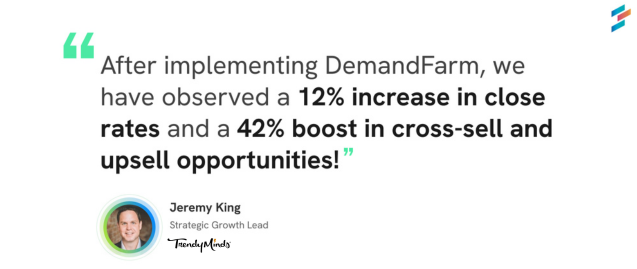Your work as a key account manager is similar to undertaking a long journey. You focus on each milestone, knowing the destination matters, but it’s the rhythm of the moment that keeps you going. If that sounds familiar, you’re already closer to the core of Robert Pirsig’s “Zen and the Art of Motorcycle Maintenance” than you might think.
Pirsig’s book dives deep into concepts like quality, relationship and reaching the destination. Surprisingly, it has a lot of takeaways about managing relationships with key clients. It’s not just about the immediate win or the next big deal—it’s about the journey, the process, and the attention to every little detail.
Sounds intriguing? There is more coming your way as we ride down the road that connects Zen and the Art of Motorcycle Maintenance and Key Account Management. Hop in for a short ride.
- The Art of Balancing the Journey and the Destination
Pirsig’s motorcycle journey with his son serves as a powerful metaphor for key account management (KAM). He reminds us that the journey itself—building lasting relationships and fostering trust—is as important as reaching the destination.
Companies that prioritize short-term gains often face revenue volatility and missed targets in the long run. Conversely, those that invest in long-term relationships can achieve sustainable growth, expanding accounts by 30% annually through cross-selling and upselling.
A leading enterprise in geographic information systems (GIS) has successfully leveraged DemandFarm’s suite of solutions, including Account Heatmap, OrgChart, Growth Plan, Account Profile, and Segmentation, to uncover an average of $2 million to $5 million in new business opportunities annually.
- Quality Over Quantity at the Heart of both Zen and KAM
Quality is paramount in Pirsig’s world (and so in KAM). He describes it as something that can’t be easily defined, but you know it when you see it. Isn’t that true about prudent account management as well? Effective KAM is about deep engagement with a few high-potential accounts rather than spreading efforts thin across too many.
Data from relationship intelligence shows that top-performing account managers spend 80% of their time engaging key decision-makers and champions, while low performers waste efforts on unqualified leads.
Prioritizing quality over quantity can drive 20% higher revenue per account. So, the real question becomes: where will you focus your efforts—on managing a long list of gatekeepers, decision makers, champions and detractors and truly investing in the ones that matter?
- Care for Key Accounts as You’d Care for a Bike’s Key Parts
Just as caring for your motorcycle’s engine, brakes, and tires accounts for 80% of issue-free travel, so too does nurturing your key accounts contribute significantly to your overall business success.
Proactive care (preventive care in motorcycling terms) can lead to 20%-30% growth per account. Additionally, companies that institutionalize QBRs and monthly check-ins with key accounts have successfully reduced churn by 25% and improved cross-sell rates by 15%.
Here’s what you need to be doing to make your 20% accounts feel cared:
- Frequent Engagement: Set up periodic check-ins and use growth planners to identify upsell opportunities.
- Value Delivery: Continuously demonstrate the ROI of your solution and keep clients aligned with your product roadmap.
- Proactive Care: Regularly conduct Quarterly Business Reviews (QBRs) and use account heatmaps to surface hidden whitespace opportunities.
They are called key accounts for a reason!
- Intuition and Logic as the Two Wheels
Pirsig often reflects on the balance between the classical and romantic modes of thought—logic and intuition. Data and intuition go hand-in-hand in KAM.
Data provides clarity on account health, and intuition is key to catching early warning signs in its relationships. Key Account Managers (KAMs) that blend relationship analytics with gut instinct increase their deal velocity by 15% (stat).
Tools like relationship maps allow KAMs to systematically track interactions, yet subtle signals—like reduced enthusiasm from a champion—often trigger early interventions that a pure data analysis can miss by a mile!
Feeling a bit lost in the intuition department? Just follow this fun formula:

Is it intuitive enough? (no pun intended!) If not, let’s just say it’s a ‘gut feeling’ that could use a little more ‘data’ to digest! (pun intended here)
- Know Your Account like You Know Your Bike’s Exhaust
When you take your motorcycle to the mechanic, the first thing they do is listen to the exhaust note. When you visit a doctor, they listen to your heartbeat. So why would KAM be any different? It’s all about listening—not just to what’s said, but also to what’s left unsaid. It’s about what is shown and also what isn’t.
Think of those signals as the exhaust notes of your client relationships:
- Is their body language (or Zoom language) relaxed or stiff?
- Are they evaluating the competition—and how will you ask about it without sounding too eager?
- What are their expectations—and are they silently signaling that they need more from you?
- How are they reacting to your limitations? Is there frustration simmering, or are they understanding?
- And when pricing comes up, especially with an RFP on the horizon, are they quietly prepping you for a showdown?
So, next time when you connect with your client, stay present and in the moment!
- Seeing the Bigger Picture and Manifesting it On the Go
In Zen and the Art of Motorcycle Maintenance, everything is connected. The state of one part affects the entire system. You might also think of it as the butterfly effect from chaos theory—a small shift in one part of your relationship can ripple outward and lead to significant consequences elsewhere.
In KAM, the same principle applies—every interaction, whether an email, a call, or a routine meeting, has the potential to influence the bigger picture. A client’s random issue isn’t just a one-off; it’s a signal connected to deeper challenges or opportunities. Address the root cause, not just the surface problem, and you’ll be on a sure path to create a partnership that endures.
- The Importance of Consistent Maintenance
Just like a well-maintained motorcycle keeps running smoothly, client relationships require regular upkeep to avoid costly breakdowns. In Key Account Management, this means consistent communication, regular check-ins, and proactive problem-solving—think of it as preventive maintenance.
Regular QBRs and monthly reviews serve as the oil changes and tune-ups for your relationships. Firms that conduct consistent QBRs report a 20% increase in client satisfaction and a 25% reduction in churn.
A Conclusion to the World of ZAMM and KAM
Effective KAM is about more than closing deals—it’s about building a foundation for long-term growth. By focusing on quality over quantity, balancing data with intuition, and maintaining a steady rhythm of engagement, account managers can unlock significant revenue opportunities.
If you had any iota of doubt (about), I hope this blog puts that to rest. Platforms like DemandFarm provide that sturdy frame, ensuring your KAM program is built to last and ready to take on new terrains. With tools like the Account Planner, Org Chart and Opportunity Planner, you have the fuel to skyrocket your revenue expansion and sustain growth for the long haul.

Ready to gear up and hit the road?



